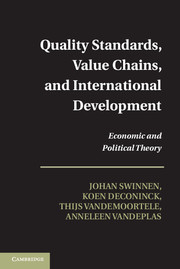Book contents
- Frontmatter
- Contents
- Preface and Acknowledgments
- 1 Introduction
- 2 Modeling Standards
- 3 Efficiency and Equity Effects of Standards
- 4 The Political Economy of Standards and Development
- 5 International Trade and Standards
- 6 Risk, Externalities, and the Nature of Standards
- 7 Endogenous Private and Public Standards in Value Chains
- 8 Butterflies and Political Economy Dynamics in Standard Setting
- 9 The Political Economy of Standards and Inclusion in Value Chains
- 10 Standards, Production Structure, and Inclusion in Value Chains
- 11 Standards, Market Imperfections, and Vertical Coordination in Value Chains
- 12 Market Power and Vertical Coordination in Value Chains
- 13 Price Transmission in Value Chains
- 14 Commodity Characteristics and Value Chain Governance
- 15 Economic Liberalization, Value Chains, and Development
- 16 Standards and Value Chains with Contracting Costs: Toward a General Model
- 17 General Equilibrium Effects of Standards in Value Chains
- References
- Index
14 - Commodity Characteristics and Value Chain Governance
Published online by Cambridge University Press: 05 August 2015
- Frontmatter
- Contents
- Preface and Acknowledgments
- 1 Introduction
- 2 Modeling Standards
- 3 Efficiency and Equity Effects of Standards
- 4 The Political Economy of Standards and Development
- 5 International Trade and Standards
- 6 Risk, Externalities, and the Nature of Standards
- 7 Endogenous Private and Public Standards in Value Chains
- 8 Butterflies and Political Economy Dynamics in Standard Setting
- 9 The Political Economy of Standards and Inclusion in Value Chains
- 10 Standards, Production Structure, and Inclusion in Value Chains
- 11 Standards, Market Imperfections, and Vertical Coordination in Value Chains
- 12 Market Power and Vertical Coordination in Value Chains
- 13 Price Transmission in Value Chains
- 14 Commodity Characteristics and Value Chain Governance
- 15 Economic Liberalization, Value Chains, and Development
- 16 Standards and Value Chains with Contracting Costs: Toward a General Model
- 17 General Equilibrium Effects of Standards in Value Chains
- References
- Index
Summary
Introduction
In the previous chapters we discussed the emergence of high-standards value chains and the distribution of rents. The rise of these high-standards value chains is important for emerging and developing countries. The 2008 World Development Report showed that high-value export products accounted for 40% of the export value for developing countries and that domestic demand for high-standards products in developing countries was growing at a speed of 6% to 7% per year (World Bank, 2007).
However, it remains unclear whether the economic potential of these high-value chains in poor countries is sufficiently large to become a poverty reduction mechanism for (a substantial part of) the rural population. Despite their robust growth in the poorest countries, and especially in Sub-Saharan Africa (SSA), the relative contribution of high value chains to output and employment remains limited (Humphrey, 2006; Minten, 2008; Tschirley et al., 2009a). Hence, an important question is to what extent the success factors of high-standards value chains can be translated into value chains of other commodity types such as traditional export crops and staple food crops, to leverage growth and achieve broad-based poverty reduction.
As is well known from work by Oliver Williamson (2002) and others, governance of exchanges along the value chain is determined by economic conditions such as the frequency of market transactions, and commodity characteristics such as asset specificity. Earlier research has identified a range of commodity characteristics affecting governance of value chains, such as perishability and input requirements (see, e.g., Benfica et al., 2002; Binswanger and Rosenzweig, 1986; Delgado, 1999; Jaffee, 1994).
In this chapter we apply the model of Chapter 11 to analyze how commodity market characteristics affect vertical coordination, explicitly accounting for two important aspects of the developing country institutional environment: market imperfections and weak enforcement mechanisms. Our analysis helps to identify the conditions under which vertical coordination could work for different commodity types.
The structure of this chapter is as follows. The next section summarizes the key differences in observed value chain governance systems for different types of commodities. Then, Section 14.3 uses the model developed in Chapter 11 to analyze how the “value” in the chain, as well as other commodity characteristics, affect the nature of value chain governance. Section 14.4 compares the theoretical outcomes of the model with observed patterns of governance in different types of commodity chains in Africa. The last section concludes the chapter.
- Type
- Chapter
- Information
- Quality Standards, Value Chains, and International DevelopmentEconomic and Political Theory, pp. 220 - 234Publisher: Cambridge University PressPrint publication year: 2015



